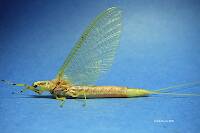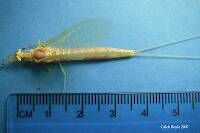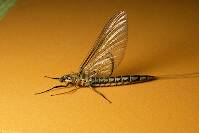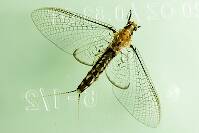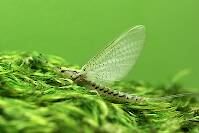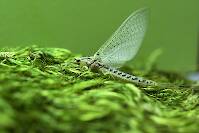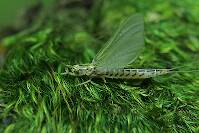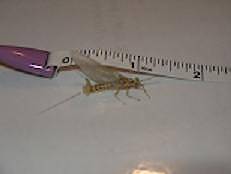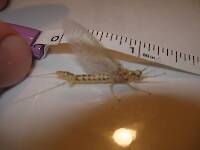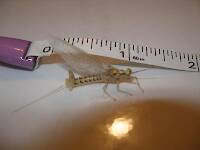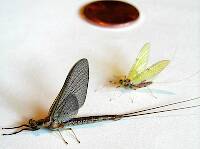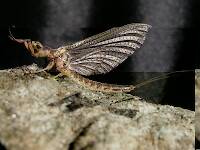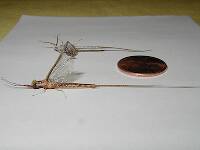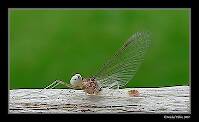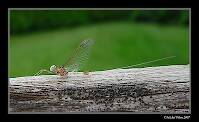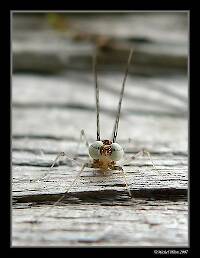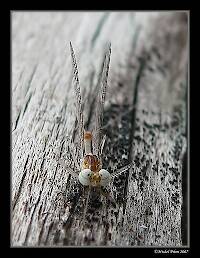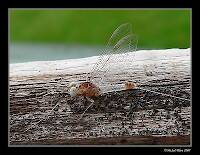
Salmonflies
Pteronarcys californica
The giant Salmonflies of the Western mountains are legendary for their proclivity to elicit consistent dry-fly action and ferocious strikes.
Featured on the forum

As far as I can tell, this species has only previously been reported from one site in Oregon along the Columbia gorge. However, the key characteristics are fairly unmistakable in all except for one minor detail:
— 4 small yellow spots on frons visible in photos
— Narrow occipital spinule row curves forward (but doesn’t quite meet on stem of ecdysial suture, as it's supposed to in this species)
— Short spinules on anterior margin of front legs
— Short rposterior row of blunt spinules on abdominal tergae, rather than elongated spinules dorsally
I caught several of these mature nymphs in the fishless, tiny headwaters of a creek high in the Wenatchee Mountains.
— 4 small yellow spots on frons visible in photos
— Narrow occipital spinule row curves forward (but doesn’t quite meet on stem of ecdysial suture, as it's supposed to in this species)
— Short spinules on anterior margin of front legs
— Short rposterior row of blunt spinules on abdominal tergae, rather than elongated spinules dorsally
I caught several of these mature nymphs in the fishless, tiny headwaters of a creek high in the Wenatchee Mountains.

Troutnut is a project started in 2003 by salmonid ecologist Jason "Troutnut" Neuswanger to help anglers and
fly tyers unabashedly embrace the entomological side of the sport. Learn more about Troutnut or
support the project for an enhanced experience here.
Konchu on Mar 12, 2012March 12th, 2012, 9:40 am EDT
Hey: I've got Dulude's book. What is it you were wanting to know at this point? I don't read or speak much French, so I hope nothing is lost in translation.
Entoman on Mar 12, 2012March 12th, 2012, 1:20 pm EDT
Ha! Great. Trying to run down any research reporting on the presence of atrocaudatus in QC. According to Michel, the author mentions its presence, and there's hope that the reference for this is in the biblio.
Thanks
Thanks
"It's not that I find fishing so important, it's just that I find all other endeavors of Man equally unimportant... And not nearly as much fun!" Robert Traver, Anatomy of a Fisherman
Konchu on Mar 12, 2012March 12th, 2012, 4:29 pm EDT
He had it listed as being in QC, but I didn't see anything to substantiate it being there. In other words, he could have expected it but not seen it yet (though I have little doubt he saw something he thought was H. atrocaudata). Curiously, I don't think he had it listed in his hatch chart.
Entoman on Mar 12, 2012March 12th, 2012, 4:44 pm EDT
Thanks Luke,
I believe the author is an angler not a scientist which was why I hoped he cited a paper in the biblio. Though he's got the number of species right, I wonder if he's confusing atrocaudata with bilineata, the third species that has been found there.
Still, I have to agree with Jason that this sure looks like atrocaudata (whatever that means). :)
I believe the author is an angler not a scientist which was why I hoped he cited a paper in the biblio. Though he's got the number of species right, I wonder if he's confusing atrocaudata with bilineata, the third species that has been found there.
Still, I have to agree with Jason that this sure looks like atrocaudata (whatever that means). :)
"It's not that I find fishing so important, it's just that I find all other endeavors of Man equally unimportant... And not nearly as much fun!" Robert Traver, Anatomy of a Fisherman
Pilonm on Mar 31, 2012March 31st, 2012, 4:44 am EDT
Hello all,
I finally succeeded to open the door of my shed :)
So I got finally the measure and know now how long it was...
Once again, I am really surprised about the results: this Hexagenia measures 1.9 cm only!!!! Wow! I was sure it was at least 40mm!!! So I realized that the big wings, the fact that he often have its front legs in front of his head and the long cerci make him looks very bigger (what an illusion)! (Imagine if it was a trout! ;-) ).
So knowing now its size, can we say for sure that it is Hexagenia atrocaudata? It seems so, isn't it?
Thanks,,
Michel
I finally succeeded to open the door of my shed :)
So I got finally the measure and know now how long it was...
Once again, I am really surprised about the results: this Hexagenia measures 1.9 cm only!!!! Wow! I was sure it was at least 40mm!!! So I realized that the big wings, the fact that he often have its front legs in front of his head and the long cerci make him looks very bigger (what an illusion)! (Imagine if it was a trout! ;-) ).
So knowing now its size, can we say for sure that it is Hexagenia atrocaudata? It seems so, isn't it?
Thanks,,
Michel
Troutnut on Mar 31, 2012March 31st, 2012, 9:11 am EDT
I'm glad you got the measurement! Those Hex mayflies do tend to look much bigger than they are.
I certainly think atrocaudata is looking pretty good as an ID now.
I certainly think atrocaudata is looking pretty good as an ID now.
Jason Neuswanger, Ph.D.
Troutnut and salmonid ecologist
Troutnut and salmonid ecologist
Entoman on Mar 31, 2012March 31st, 2012, 9:21 am EDT
I certainly think atrocaudata is looking pretty good as an ID now.
I agree. Thanks for following up on the measurement, Michel.
"It's not that I find fishing so important, it's just that I find all other endeavors of Man equally unimportant... And not nearly as much fun!" Robert Traver, Anatomy of a Fisherman
Taxon on Mar 31, 2012March 31st, 2012, 2:48 pm EDT
So knowing now its size, can we say for sure that it is Hexagenia atrocaudata? It seems so, isn't it?
So Michel, does this mean that mean I have your blessing to move it back to H. atrocaudata in BugGuide?
Pilonm on Apr 1, 2012April 1st, 2012, 5:50 am EDT
Of course Roger :)
Cheers,
Michel
Cheers,
Michel
Pilonm on Apr 1, 2012April 1st, 2012, 5:53 am EDT
Also, I want to thanks everybody on this forum for helping me so much on this ID. I learned so much reading your so pertinent posts!!!
You are great people :D
Cheers,
Michel
You are great people :D
Cheers,
Michel
Quick Reply
Related Discussions
Topic
Replies
Last Reply
1
Aug 1, 2008
by Troutnut
by Troutnut
3
May 31, 2016
by Oldredbarn
by Oldredbarn
10
Jun 30, 2009
by Jmd123
by Jmd123
5
Oct 17, 2007
by Pilonm
by Pilonm






